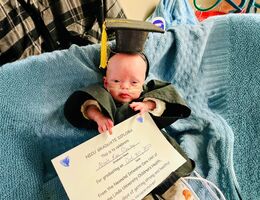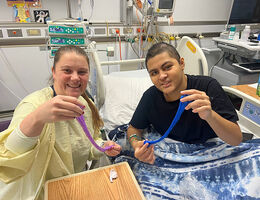
Dr. Jennifer Dunbar and her patient Thomas
Good vision is essential for a child's clear sight and plays a significant role in learning, school readiness, and motor skills development. Jennifer Dunbar, MD, a pediatric ophthalmologist at Loma Linda University Health and vice chair of the Loma Linda Eye Institute, emphasizes the importance of parents being vigilant about their child's eye health.
"A child's brain makes nerve connections for vision from birth through early grade school years, making early childhood a critical period for vision development," said Dunbar.
Early detection and treatment of vision problems can significantly impact a child's development and quality of life. Vision screenings should start at birth and continue regularly throughout childhood. The American Academy of Pediatrics recommends vision screenings during well-child visits, with specific evaluations at birth, one month, three months, six months, and annually.
Common Vision Problems in Children
Several vision problems can affect children, including:
-
Amblyopia (Lazy Eye): A condition where one eye is weaker, causing the brain to favor the stronger eye. If left untreated, it can lead to permanent vision loss in the weaker eye.
-
Strabismus (Crossed Eyes): Occurs when the eyes do not align properly, with one eye turning in, out, up, or down. Early detection and treatment are necessary to prevent vision problems and ensure eye coordination.
-
Refractive Errors: These include nearsightedness (myopia), farsightedness (hyperopia), and astigmatism, causing blurry vision. They can often be corrected with glasses or contact lenses.
-
Congenital Cataracts: This is present at birth and can block vision if not treated promptly. Surgery is often required to remove the cataract to allow normal vision development.
Signs of Vision Problems
Parents should watch for signs of vision problems in their children:
- Squinting
- Frequent eye rubbing
- Complaints of headaches or tired eyes
- Difficulty reading or holding books very close to the face
- Misaligned eyes
Pediatricians and schools typically screen children for eye issues such as asymmetry and congenital anomalies like cataracts. If any problems are detected, children are referred for further evaluation by an ophthalmologist.
"Misaligned eyes are more than a cosmetic issue. They can indicate that the brain is not developing vision properly, which can affect a child's ability to see for the rest of their life," Dunbar said.
Parents should also be mindful of behaviors that might harm their child's vision. Extensive screen time and frequent eye rubbing can increase the need for glasses. The American Academy of Pediatrics recommends limiting screen time to two hours a day for children over two years old.
Dunbar encourages parents to have their children play outside regularly, as it reduces the risk of developing myopia. Additionally, a balanced diet rich in vitamins and minerals supports eye health. Foods high in vitamins A, C, and E and omega-3 fatty acids are particularly beneficial.
For more information, visit the Loma Linda Eye Institute's website.


